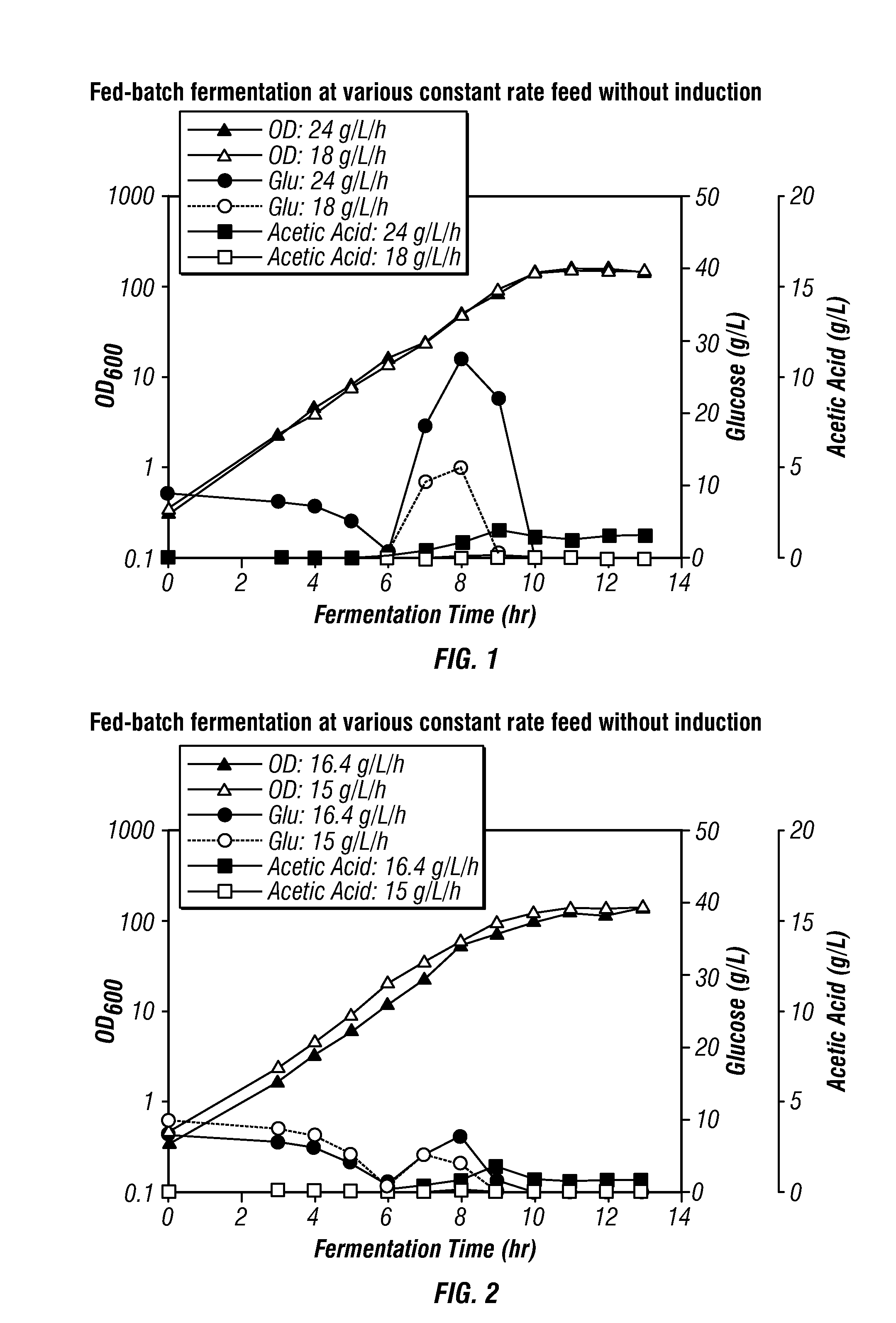High-cell density fed-batch fermentation process for producing recombinant protein
a high-cell density, fed-batch technology, applied in the direction of instruments, peptides, microorganisms, etc., can solve the problems of distorting the feed rate and the resulting protein yield, accompanied by the application of feedback algorithms, and affecting the etc., to achieve the effect of high yield of recombinant proteins
- Summary
- Abstract
- Description
- Claims
- Application Information
AI Technical Summary
Benefits of technology
Problems solved by technology
Method used
Image
Examples
example 1
Fed-Batch Fermentation with Constant Rate Feed
[0106]E. coli (pPW62) subfamily B was used as a model strain for a fed-batch fermentation process. Based on the results, the process will be applied to the subfamily A E. coli (pPW102).
[0107]A medium and feed solution for the fed-batch fermentation was prepared using the components as listed in the following tables.
Medium and Feed Solution
[0108]
TABLE 1Basal MediumComponentQuantity per LiterDextrose, Anhydrous10gKH2PO43gK2HPO47g(NH4)2SO41gSodium Citrate, Dihydrate1gMgSO4•7H2O1g(Na)2SO40.58gCaCl2•2H2O0.075gFeSO4•7H2O0.09g1000x Trace Metal Stock Solution (Table1mL6)Chloramphenicol15mg
[0109]
TABLE 21000x Trace Metal Stock SolutionComponentQuantity per LiterZnSO4•7H2O 30 gCuSO4•5H2O 9 gMnSO4•H2O4.2 gCoCl2•6H2O0.6 gMolybdic Acid, Ammonium Salt,1.5 gTetrahydrate
[0110]
TABLE 3Glucose Concentrate Feed SolutionComponentQuantity per LiterGlucose500 / 700gKH2PO43gK2HPO45g(NH4)2SO42g
[0111]
TABLE 4Arabinose Concentrate Feed SolutionComponentQuantity per L...
example 3
Scaled-Up Fed-Batch Fermentation to 100 L Scale
[0131]The seed culture was started by inoculating 2×1 L basal medium containing 15 μg / mL chloramphenicol with 1 ml (that is, 1 vial) of thawed working seed. The culture in 2.8 L Fernbach was incubated for about 16 hours at 32° C. and 150 rpm in a rotary shaker.
[0132]Two 1 L overnight Fernbach seed cultures were aseptically transferred into a 150 L termentor containing 70 L basal medium without chloramphenicol. The 150 L fermentation in basal medium was controlled at pH 7.0±0.05 by 7.4 N NH4OH, temperature 36° C., DO 20%, and air flow at 1 vvm. The DO was controlled by a cascade of agitation and oxygen addition. Antifoam PPG-2000 was automatically added to control foam. During the fermentation, the DO dropped from 100% to 20% and was maintained at 20%. When there was a sharp rise in DO from 20% to greater than 40% (usually at OD ˜20), signaling the depletion of glucose, the feed pump was activated to deliver the glucose concentrate (that...
PUM
| Property | Measurement | Unit |
|---|---|---|
| cell density | aaaaa | aaaaa |
| density | aaaaa | aaaaa |
| pH | aaaaa | aaaaa |
Abstract
Description
Claims
Application Information
 Login to View More
Login to View More - R&D
- Intellectual Property
- Life Sciences
- Materials
- Tech Scout
- Unparalleled Data Quality
- Higher Quality Content
- 60% Fewer Hallucinations
Browse by: Latest US Patents, China's latest patents, Technical Efficacy Thesaurus, Application Domain, Technology Topic, Popular Technical Reports.
© 2025 PatSnap. All rights reserved.Legal|Privacy policy|Modern Slavery Act Transparency Statement|Sitemap|About US| Contact US: help@patsnap.com



